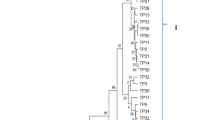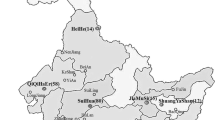Abstract
Rhizoctonia solani (teleomorph: Thanatephorus cucumeris) is a ubiquitous plant pathogen infects various agricultural and horticultural crops. In this investigation, isolates of R. solani were collected from collar-rot infected dhaincha plants and black scurf affected potato tubers from potato based crop rotation to determine their morphological variability, mycelial compatibility and cross-infectivity. Significant variations in cultural and morphological features were observed among and between the R. solani isolates from both the hosts. Dhaincha isolates grew faster than those potato isolates and hyphal width of both host isolates varied from 6.24 to 11.70 μm. Considerable variability was observed in sclerotial characteristics viz. sclerotia colour, size, intensity, and distribution pattern. Most of the dhaincha isolates produced macro (> 1.26 mm) size sclerotia while potato isolates formed micro (≤ 1.25 mm) size sclerotia. Hyphal interaction studies showed that all isolates from potato belonged to AG-3 and dhaincha isolates belonged to AG1-IA group. Mycelial compatibility studies revealed that 76.67% of pairing was compatible while 23.33% of pairing exhibited non-compatible interaction. Cross-infectivity test revealed that R. solani potato isolates did not infect dhaincha plants whereas dhaincha isolates showed the varied degree of pathogenicity on potato and Rhizoctonia-like atypical symptoms were observed on the tuber surface. In this study, we report the first time of R. solani AG composition infecting potato in dhaincha-potato rotation in India. The outcomes of this study will be helpful for developing management strategies and breeding programs on varietal evaluation for effective control of Rhizoctonia diseases of potatoes.







Similar content being viewed by others
Data Availability
It is not applicaable to this research paper.
References
Acosta-Martınez V, Burow G, Zobeck TM, Allen VG (2010) Soil microbial communities and function in alternative systems to continuous cotton. Soil Sci Soc Am J 74:1181–1192
Ali M, Singh R, Lal M, Chaudhary S, Kumar S, Ahmad S (2019) Determination the role of weeds hosts in spreading of sheath blight from weed to rice crop in Western plain zone of Uttar Pradesh, India. Int J Microbiol Appl Sci 8:972–982
Anderson NA (1982) The genetics and pathology of Rhizoctonia soilani. Annu Rev Phytopathol 20:329–347
Carling DE (1996) Grouping in Rhizoctonia solani by the anastomosis reaction. In: Sneh B, Jabaji-Hare S, Neate S, Dijst G (eds) Rhizoctonia species: taxonomy, molecular biology, ecology, pathology and disease control. Springer, Dordrecht, pp 37–47
Carling DE, Sumner DR (1992) Rhizoctonia. In: Singleton LL, Mihail JD, Rush CM (eds) Methods for research on soilborne phytopathogenic fungi. American Phytopathological Society, St. Paul, pp 157–165
Carling DE, Baird RE, Gitaitis RD, Brainard KA, Kuninaga S (2002) Characterization of AG-13, a newly reported anastomosis group of Rhizoctonia solani. Phytopathology 92:893–899
Ceresini PC, Shew HD, Vilgalys RJ, Cubeta MA (2002) Genetic diversity of Rhizoctonia solani AG-3 from potato and tobacco in North Carolina. Mycologia 94:437–449
Chaudhary S, Sagar S, Tomar A, Sengar RS, Kumar AM (2016) Banded leaf and sheath blight: a menacing disease of maize (Zea mays L.) and its management. J Appl Nat Sci 8:1720–1730
Chuadhary S, Lal M, Sagar S, Tyagi H, Kumar M, Shrama S, Chakrabarti SK (2020a) Genetic diversity studies based on morpho-pathological and molecular variability of the Sclerotinia sclerotiorum population infecting potato (Solanum tuberosum L.). World J Microbiol Biotechnol 36:177
Chaudhary S, Sagar S, Lal M, Tomar A, Kumar V, Kumar M (2020b) Biocontrol and growth enhancement potential of Trichoderma spp. against Rhizoctonia solani causing sheath blight disease in rice. J Environ Biol 41:1034–1045
Das S, Shah FA, Butler RC, Falloon RE, Stewart A, Raikar S, Pitman AR (2014) Genetic variability and pathogenicity of Rhizoctonia solani associated with black scurf of potato in New Zealand. Plant Pathol 63:651–666
Fiers M, Edel-Hermann V, Heraud C, Gautheron N, Chatot C, Hingrat YL (2011) Genetic diversity of Rhizoctonia solani associated with potato tubers in France. Mycologia 103:1230–1244
Gan Y, Liang C, Chai Q, Lemke RL, Campbell CA, Zentner RP (2014) Improving farming practices reduces the carbon footprint of spring wheat production. Nat Commun 5:1–13
Gan Y, Hamel C, O’Donovan JT, Cutforth H, Zentner RP, Campbell CA, Niu Y, Poppy L (2015) Diversifying crop rotations with pulses enhances system productivity. Sci Rep 5:14625
Ganeshamoorthi P, Dubey SC (2015) Morphological and pathogenic variability of R. solani isolates associated with wet root rot of chickpea in India. Legum Res 38:389–395
Gilligan CA, Simons SA, Hide GA (1996) Inoculum density and spatial pattern of Rhizoctonia solani in field plots of Solanum tuberosum: effect of cropping frequency. Plant Pathol 45:232–244
Glass NL, Kaneko I (2003) Fatal attraction: Nonself recognition and heterokaryon incompatibility in filamentous fungi. Eukaryot Cell 2:1–8
González D, Rodríguez-Carres M, Boekhout T, Stalpers J, Kuramae EE, Nakatani AK, Vilgalys R, Cubeta MA (2016) Phylogenetic relationships of Rhizoctonia fungi within the Cantharellales. Fungal Biol 120:603–619
Goswami BK, Bhuiyan KA, Mian IH (2010) Morphological and pathogenic variations in the isolates of Rhizoctonia solani in Bangladesh. Bangladesh J Agric Res 35:375–380
Hossain MA, Becker K (2001) Nutritive value and antinutritional factors in different varieties of Sesbania seeds and their morphological fractions. Food Chem 73:421–431
Hu Y, Guo TW, Zhang XC (2009) Effect of potato continuous cropping on soil nutrients in dry land. J Anhui Agric Sci 37(12):5436–5439
Hussain A, Awan SM, Iqbal M, Anees M, Ali S (2014) Variability among the potato sclerotial isolates of Rhizoctonia solani of Mountainous region, Gilgit-Baltistan, Pakistan. Afr J Microbiol Res 8:2849–2860
Jahan MS, Rawshan S, Banu T, Chowdhury DNA, Noori A, Al-Maruf A (2009) Effect of harvesting age on the chemical and morphological properties of dhaincha (Sesbania aculeata) and its pulpability and bleachability. BioResources 4:471–481
Keijer J, Korsman MG, Dullemans A, Houterman PM, Bree J, Van Silfhout CH (1997) In vitro analysis of host plant specificity in Rhizoctonia solani. Plant Pathol 46:659–669
Khandaker M, Khair A, Bhuiyan MKA (2008) Disease reaction of different crops against virulent potato isolates of Rhizoctonia solani Kuhn. Bangladesh J Bot 37:75–80
Kluth C, Buhre C, Varrelmann M (2010) Susceptibility of intercrops to infection with Rhizoctonia solani AG2-2 IIIB and influence on subsequently cultivated sugar beet. Plant Pathol 59:683–692
Kroland WC, Stanghellini ME (1988) Clean slide technique for the observation of the anastomosis and nuclear condition of Rhizoctonia solani. Phytopathology 78:820–822
Lal M, Kandhari J (2009) Cultural and morphological variability in Rhizoctoia solani isolates causing sheath blight of rice. J Mycol Plant Pathol 39:77–81
Lal M, Chaudhary S, Kumar M, Sharma S, Chakrabarti SK (2020) First report of collar and stem rot caused by Rhizoctonia solani AG1-IA on Sesbania sesban in India. Plant Dis 104:3251
Lal M, Kumar A, Chaudhary S, Singh RK, Sharma S, Kumar M (2022) Antagonistic and growth enhancement activities of native Pseudomonas spp against soil and tuber-borne diseases of potato (Solanum tuberosum L.). Egypt J Biol Pest Control. 32:22. https://doi.org/10.1186/s41938-022-00522-w
Lehtonen MJ, Ahvenniemi P, Wilson PS, German-Kinnari M, Valkonen JPT (2008) Biological diversity of Rhizoctonia solani (AG-3) in a northern potato-cultivation environment in Finland. Plant Pathol 57:141–151
Ma K, Zhang L, Du Q, Song NP (2010) Effect of potato continuous cropping on soil microorganism community structure and function. J Soil Water Conserv 4:229–233
MacNish GC, Carling DE, Brainard KA (1997) Relationship of microscopic and macroscopic vegetative reactions in Rhizoctonia solani and the occurrence of vegetatively compatible populations (VCPs) in AG8. Mycol Res 101:61–68
Meng PP, Liu X, Qiu HZ, Zhang WR, Zhang CH, Wang D, Zhang JL, Shen QR (2012) Fungal population structure and its biological effect in rhizosphere soil of continuously cropped potato. Chin J Appl Ecol 23(11):3079–3086
Misra LN, Siddiqui SA (2004) Dhaincha (Sesbania bispinosa) leaves: a good source of antidiabetic (+)-pinitol. Curr Sci 87:10
Moulin AP, Buckley KE, Volkmar K (2011) Soil quality as affected by amendments in bean–potato rotations. Can J Soil Sci 91:533–542
Muzhinji N, Truter M, van der Waals JE (2015) First report of Rhizoctonia solani AG 4HG-III causing potato stem canker in South Africa. Plant Dis 100:555–564
Naito S (2004) Rhizoctonia diseases: taxonomy and population biology. In: Proceeding of the international seminar on biological control of soilborne plant pathogens, Japan–Argentina joint study, Buenos Aires, Argentina, pp 18–31
Naz F, Rauf CA, Abbasi NA, Haque I, Ahmad I (2008) Influence of inoculum levels of Rhizoctonia solani and susceptibility of new potato germplasm. Pak J Bot 40:2199–2209
Ndoye I, Tomekpe K, Dreyfus B, Dommergues YR (1990) Sesbania and Rhizobium symbiosis: nodulation and nitrogen fixation. In: Macklin B, Evans DO (eds) Perennial Sesbania species in agroforestry systems. Nitrogen Fixing Tree Association, Wamanalo, pp 31–38
Ogoshi A (1987) Ecology and pathogenicity of anastomosis and intraspecific groups of Rhizoctonia solani Kuhn. Annu Rev Phytopathol 25:125–143
Palaniappan SP, Siddeswaran K (2001) Regional overview on green manure in rice-based cropping systems. In: Gowda CLL, Ramakrishna A, Rupela OP, Wani SP (eds) Legumes in rice based cropping systems in Tropical Asia: constraints and opportunities. International Crops Research Institute for the Semi-Arid Tropics, Patancheru, pp 126–135
Rangaswami G, Mahadevam A (2004) Diseases of crop plants in India. Prentice Hall of India Pvt. Ltd, New Delhi, pp 65–66
Rosa LF, Johan MC, Paulo C, Celsa GD (2012) Rhizoctonia solani AG-3PT is the major pathogen associated with potato stem canker and black scurf in Colombia. Agro Colombiana 30:204–213
Sharma S (2015) Black Scurf. In: Singh BP, Nagesh M, Sharma S, Sagar V, Jeevlatha A, Sridhar J (eds) A manual on diseases and pest of potato, Tech Bull No. 101. ICAR-Central Potato Research Institute, Shimla, pp 11–13
Sharma AR, Das KC (1994) Effect of green manuring with dhaincha (Sesbania aculeate) on growth and yield of direct-sown and transplanted rice under intermediate deepwater conditions (0–50 cm). J Agric Sci 122:359–364
Singh V, Singh US, Singh KP, Singh M, Kumar A (2002) Genetic diversity of Rhizoctonia solani isolates from rice: differentiation by morphological characteristics, pathogenicity, anastomosis behaviour and RAPD fingerprinting. J Mycol Plant Pathol 32:332–344
Sneh B, Burpee L, Ogoshi A (1991) Identification of Rhizoctonia species. APS Press, St. Paul
Sunder S, Singh R, Dodan DS (2003) Standardization of inoculation methods and management of sheath blight of rice. Indian J Plant Pathol 21:92–96
Thind TS, Aggarwal A (2008) Characterization and pathogenic relationship of Rhizoctonia solani isolates in a potato-rice system and their sensitivity to fungicides. J Phytopathol 156:615–621
Trabelsi D, Ammarb HB, Mengoni A, Mhamdi R (2012) Appraisal of the crop-rotation effect of rhizobial inoculation on potato cropping systems in relation to soil bacterial communities. Soil Biol Biochem 54:1–6
Tsror L (2010) Biology, epidemiology and management of Rhizoctonia solani on potato. J Phytopathol 158:649–658
Vineeta S, Singh US, Singh KP, Major S, Kumar A (2002) Genetic diversity of Rhizoctonia solani isolates from rice: differentiation by morphological characteristics, pathogenicity, anastomosis behaviour and RAPD fingerprinting. J Mycol Plant Pathol 32:332–344
Wang L, Liu LM, Wang ZG, Huang SW (2013) Genetic structure and aggressiveness of Rhizoctonia solani AG 1-IA, the cause of sheath blight of rice in southern China. J Phytopathol 161:753–762
Woodhall JW, Lees AK, Edwards SG, Jenkinson P (2007) Characterization of Rhizoctonia solani from potato in Great Britain. Plant Pathol 56:286–295
Woodhall JW, Lees AK, Edwards SG, Jenkinson P (2008) Infection of potato by Rhizoctonia solani: effect of anastomosis group. Plant Pathol 57:697–905
Acknowledgements
The present work is based upon research supported by the research grant (EEQ/2016/000298) of the Science and Engineering Research Board (SERB)-Department of Science and Technology (DST), Government of India.
Author information
Authors and Affiliations
Corresponding author
Ethics declarations
Conflict of interest
All authors have declared no conflict of interest.
Additional information
Publisher's Note
Springer Nature remains neutral with regard to jurisdictional claims in published maps and institutional affiliations.
Rights and permissions
Springer Nature or its licensor (e.g. a society or other partner) holds exclusive rights to this article under a publishing agreement with the author(s) or other rightsholder(s); author self-archiving of the accepted manuscript version of this article is solely governed by the terms of such publishing agreement and applicable law.
About this article
Cite this article
Chaudhary, S., Sharma, S., Lal, M. et al. Morphological and pathological variability of Rhizoctonia solani isolates from dhaincha-potato crop rotation and their mycelial compatibility relationship. Indian Phytopathology 76, 355–369 (2023). https://doi.org/10.1007/s42360-023-00594-0
Received:
Revised:
Accepted:
Published:
Issue Date:
DOI: https://doi.org/10.1007/s42360-023-00594-0




